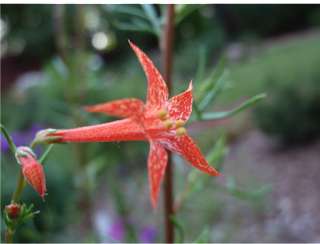If you are a newcomer to the world of flower gardening, welcome! Prepare to have a new addiction in your life. Getting familiar with some of the terminology will help you navigate the wonderful world of annuals, perennials, bulbs and more. Here’s a start.
 |
| Annuals in a container, photo by Beth Bonnicksen |
Annuals: Annual plants complete their life cycle in a single year, from seedling to bloom to setting seed. This means they won’t come back next year…unless they self seed (like some snapdragons and marigolds). Annuals let you mix up your garden design every year, keep your containers blooming, and fill in gaps in perennial beds. Tips for success with annuals:
- Containers: pack them in! Fertilize according to package directions;
- Group plants with similar sunlight and water needs;
- Keep seeds and seedlings damp until established;
- Deadhead during the growing season.
 |
| Ipomopsis, Scarlet gilia, a native biennial, photo by Donna Duffy |
Biennials: Biennial plants complete their life cycle in two years.
- Expect them to reseed and plan accordingly;
- If they don’t self seed, replant seeds every year for continuous bloom;
- Don’t yank them up the first year because they aren’t blooming!
 |
| Perennials in early summer, photo by Donna Duffy |
Perennials: Perennial plants live through multiple growing seasons. Because they will be with you for years, it’s important to pay attention to the label to determine growing needs and size. It’s often said that the perennial growing cycle for the first three years is “sleep, creep, leap”.
- Tempting as it is, don’t plant perennials closer together than the label recommends because most of them increase in size over time;
- Perennials can be cut back in fall or spring;
- Most perennials respond well to being divided and moved.
 |
| Pulsatilla patens, Pasqueflower, a Colorado native, photo by Donna Duffy |
Native Plants occur naturally in a particular region, state, ecosystem or habitat. They survive without direct or indirect human actions, and were here before the advent of European settlement. Many natives are adaptable to urban landscapes, and are becoming more available at garden centers. Harvesting seeds from public land is NOT permitted. Native plants generally require less water, attract birds and pollinators, and require less soil amendment. Check out the CSU publication Native Herbaceous Perennials for Colorado Landscapes for more information.
Bulbs: Spring blooming bulbs like tulips and daffodils are planted in the fall before the ground freezes. They typically bloom between late March and May. They will return for several years. Summer blooming bulbs like gladiolus and calla and canna lily are planted in the spring after the threat of frost has passed. Consider them annuals as they will not overwinter in Colorado.
Corms look like small bulbs, but don’t have the onion-like layers that tulip bulbs have. Crocus are grown from corms. There are both spring and fall blooming crocus.
 |
| Iris, photo by Carol King |
Rhizomes are shallow, horizontal underground stems that strike new roots out of their nodes and shoot new stems upward out of the nodes. Iris rhizomes need to be pulled up and divided every few years to keep them blooming.
Tubers are swollen, underground plant parts that store food. Dahlias grow from tubers and require fall digging and winter storage.
With that information in hand, you can start researching flowering plants for your landscape! Hurry up, Spring!






